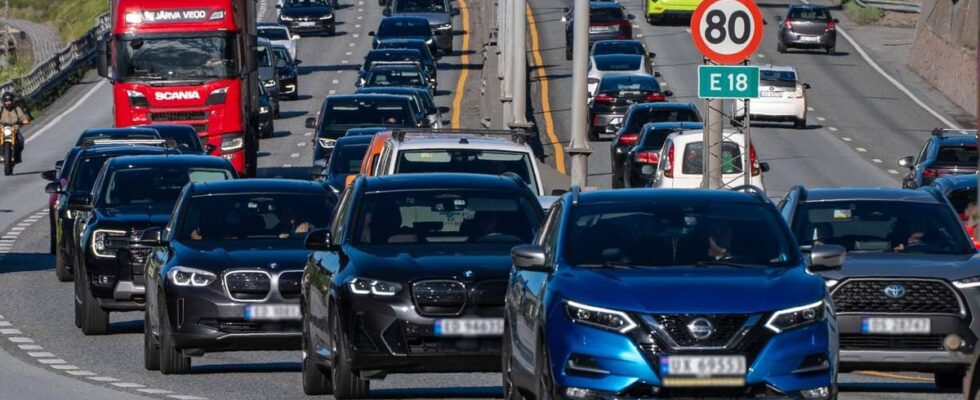Some people like to sit in traffic queues. You get time to yourself, can enjoy coffee in a thermos cup and listen to music, radio or podcasts. But for most people, the queues in and out of the city are annoying and frustrating. Perhaps you have an important meeting at work where a number of colleagues are sitting and waiting. Perhaps the nursery school is about to close while the employees are impatient to go home for dinner. And for goods transport, standing in queues results in a direct loss of income. 5.1 billion minimum For the queues also have their price in kroner and øre. The Road Traffic Information Council (OFV) has commissioned Vista Analysis to calculate what the delays around Oslo cost in lost time for private cars and heavy traffic. – On six of the main road sections in and out of Oslo, it costs society at least NOK 5.1 billion to stand in queues, says director Øyvind Solberg Thorsen. Øyvind Solberg Thorsen is director of the Road Traffic Information Council. Photo: Olav Juven / news – And with the closure of Ring 1 it will perhaps get even worse? – Much worse. We now see that the queues are also there at weekends and that people are not doing private errands because it takes far too long. And there is a lot of traffic on a number of small roads too, and that adds up, he says. NOK 5.1 billion is more than motorists in the Oslo area pay in tolls each year. What do you think about standing in traffic queues? It’s very annoying. I don’t like it, but I’ve calculated the time on a daily basis, and it takes even longer to travel by public transport. The Norwegian Public Roads Administration and the Transport Economics Institute calculate the socio-economic benefits of large projects. Here, the delays are calculated into kroner and øre for the six main roads. E18 west (Asker – Sørenga): NOK 1,445 million. per year E6 north (Kløfta – Sørenga): NOK 1,247 million. per year E6 south (Vinterbro – Sørenga): NOK 875 million. per year Ring 3 (Ryen – Lysaker): NOK 1,109 million. per year E18 south (Vinterbro – Sørenga): NOK 266 million. per year Rv.159 (Lillestrøm – Furuset) 159 million per year MOST QUEUES: The stretch Blommenholm – Lysaker on the E18 in Bærum is the worst queue in the morning rush hour. Photo: Rolf Petter Olaisen / news E18 from west worst A separate so-called accessibility index shows where the delays are greatest in half-hour intervals throughout the day. In the morning rush hour, there is the most traffic on the E18 from the west. By far the worst here is the section Blommenholm – Lysaker. In the afternoon it is worst on Ring 3 and on Rv.159 at Romerike. On Ring 3, you mostly stomp between Sinsen and Ullevål. On Rv.159, the stop is the roundabout at the end of the Rælingstunnel. The calculations were made before the ban on electric cars in public transport was introduced in May. Price the motorists away? According to Øyvind Thorsen in OFV, it is not a quick fix to overcome the queues. The report from Vista shows that it is unrealistic to build one’s way out of the problems. Nor can better public transport solve everything. In that case, it will be far too expensive. According to the report, the most effective measure is to price motorists away from the road during rush hour. Rush hour fees in the toll stations already exist, but there is more to be gained here, Thorsen believes. But there is a limit. – Do we want a situation where it might cost NOK 250 to pass the barrier for an ordinary private car in the morning into Oslo? No, I probably don’t think so. It is also difficult politically, he says. – But what we could do is raise the price somewhat during rush hour and lower or remove the cost at other times of the day. We have not done that enough in the Oslo area, nor elsewhere in the country, says Øyvind Thorsen. Traffic lights before the motorways He also points to another measure which has not been tried, but which will improve traffic flow on the main roads. It is to let fewer cars in at a time from the approaches so that the cars on the motorway do not have to slow down. – Everyone who is going on a main road may have to be allowed into pools, by using light regulation, for example. – Then you move the queues and the environmental problems onto the minor roads? You do that, so it must also be thought about carefully, says Øyvind Solberg Thorsen. CALL 3: Access here is worst during the afternoon rush hour. Photo: Hallgeir Braastad / news Published 04.07.2024, at 06.25 Updated 04.07.2024, at 07.16
ttn-69
Queues in the Oslo area cost society at least NOK 5.1 billion – Greater Oslo

